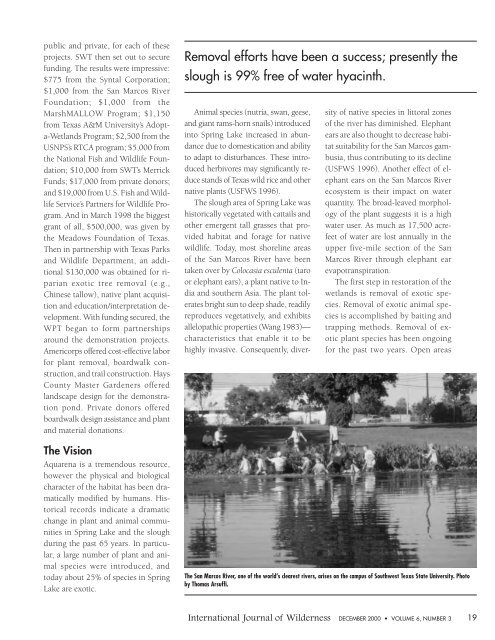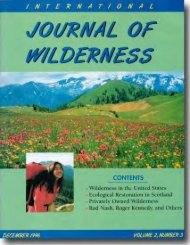Download full PDF - International Journal of Wilderness
Download full PDF - International Journal of Wilderness
Download full PDF - International Journal of Wilderness
Create successful ePaper yourself
Turn your PDF publications into a flip-book with our unique Google optimized e-Paper software.
public and private, for each <strong>of</strong> these<br />
projects. SWT then set out to secure<br />
funding. The results were impressive:<br />
$775 from the Syntal Corporation;<br />
$1,000 from the San Marcos River<br />
Foundation; $1,000 from the<br />
MarshMALLOW Program; $1,150<br />
from Texas A&M University’s Adopta-Wetlands<br />
Program; $2,500 from the<br />
USNPS’s RTCA program; $5,000 from<br />
the National Fish and Wildlife Foundation;<br />
$10,000 from SWT’s Merrick<br />
Funds; $17,000 from private donors;<br />
and $19,000 from U.S. Fish and Wildlife<br />
Service’s Partners for Wildlife Program.<br />
And in March 1998 the biggest<br />
grant <strong>of</strong> all, $500,000, was given by<br />
the Meadows Foundation <strong>of</strong> Texas.<br />
Then in partnership with Texas Parks<br />
and Wildlife Department, an additional<br />
$130,000 was obtained for riparian<br />
exotic tree removal (e.g.,<br />
Chinese tallow), native plant acquisition<br />
and education/interpretation development.<br />
With funding secured, the<br />
WPT began to form partnerships<br />
around the demonstration projects.<br />
Americorps <strong>of</strong>fered cost-effective labor<br />
for plant removal, boardwalk construction,<br />
and trail construction. Hays<br />
County Master Gardeners <strong>of</strong>fered<br />
landscape design for the demonstration<br />
pond. Private donors <strong>of</strong>fered<br />
boardwalk design assistance and plant<br />
and material donations.<br />
The Vision<br />
Aquarena is a tremendous resource,<br />
however the physical and biological<br />
character <strong>of</strong> the habitat has been dramatically<br />
modified by humans. Historical<br />
records indicate a dramatic<br />
change in plant and animal communities<br />
in Spring Lake and the slough<br />
during the past 65 years. In particular,<br />
a large number <strong>of</strong> plant and animal<br />
species were introduced, and<br />
today about 25% <strong>of</strong> species in Spring<br />
Lake are exotic.<br />
Removal efforts have been a success; presently the<br />
slough is 99% free <strong>of</strong> water hyacinth.<br />
Animal species (nutria, swan, geese,<br />
and giant rams-horn snails) introduced<br />
into Spring Lake increased in abundance<br />
due to domestication and ability<br />
to adapt to disturbances. These introduced<br />
herbivores may significantly reduce<br />
stands <strong>of</strong> Texas wild rice and other<br />
native plants (USFWS 1996).<br />
The slough area <strong>of</strong> Spring Lake was<br />
historically vegetated with cattails and<br />
other emergent tall grasses that provided<br />
habitat and forage for native<br />
wildlife. Today, most shoreline areas<br />
<strong>of</strong> the San Marcos River have been<br />
taken over by Colocasia esculenta (taro<br />
or elephant ears), a plant native to India<br />
and southern Asia. The plant tolerates<br />
bright sun to deep shade, readily<br />
reproduces vegetatively, and exhibits<br />
allelopathic properties (Wang 1983)—<br />
characteristics that enable it to be<br />
highly invasive. Consequently, diver-<br />
sity <strong>of</strong> native species in littoral zones<br />
<strong>of</strong> the river has diminished. Elephant<br />
ears are also thought to decrease habitat<br />
suitability for the San Marcos gambusia,<br />
thus contributing to its decline<br />
(USFWS 1996). Another effect <strong>of</strong> elephant<br />
ears on the San Marcos River<br />
ecosystem is their impact on water<br />
quantity. The broad-leaved morphology<br />
<strong>of</strong> the plant suggests it is a high<br />
water user. As much as 17,500 acrefeet<br />
<strong>of</strong> water are lost annually in the<br />
upper five-mile section <strong>of</strong> the San<br />
Marcos River through elephant ear<br />
evapotranspiration.<br />
The first step in restoration <strong>of</strong> the<br />
wetlands is removal <strong>of</strong> exotic species.<br />
Removal <strong>of</strong> exotic animal species<br />
is accomplished by baiting and<br />
trapping methods. Removal <strong>of</strong> exotic<br />
plant species has been ongoing<br />
for the past two years. Open areas<br />
The San Marcos River, one <strong>of</strong> the world’s clearest rivers, arises on the campus <strong>of</strong> Southwest Texas State University. Photo<br />
by Thomas Arsuffi.<br />
<strong>International</strong> <strong>Journal</strong> <strong>of</strong> <strong>Wilderness</strong> DECEMBER 2000 • VOLUME 6, NUMBER 3 19










